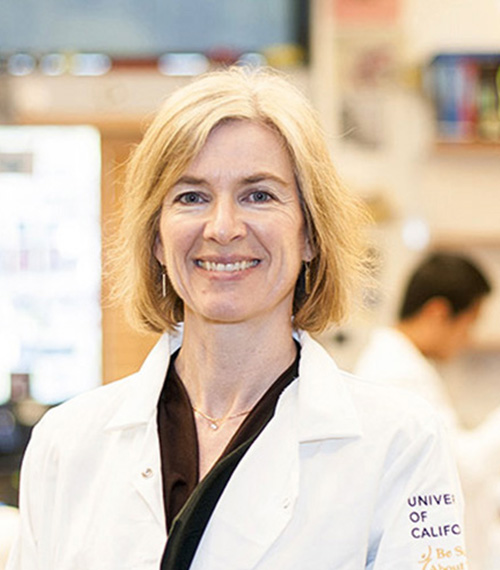Jennifer Doudna (Washington D.C. United States; 1964) graduated ‘cum laude’ in biochemistry from Pomona College (1985) then went on to earn a PhD in Biological Chemistry and Molecular Pharmacology at Harvard Medical School (1989).
From 1989 to 1994, she pursued postdoctoral work at Massachusetts General Hospital, Harvard Medical School and the University of Colorado. Between 1994 and 2002, she held a series of positions in the Department of Molecular Biophysics and Biochemistry at Yale University, latterly as Henry Ford II Professor (2000-2002). Since then, Doudna has been attached to the University of California, Berkeley, where she is currently Professor of Chemistry and Molecular Biology at the University of California, Berkeley
She also holds the Li Ka Shing Chancellor’s Chair in Biomedical Sciences at this same center, is Executive Director of the Innovative Genomics Initiative and chairs the Chancellor’s Advisory Committee on Biology. She has been a researcher with the Howard Hughes Medical Institute since 1997.
Speech
Biomedicine 9th edition
Micro interview
“Scientists should be more engaged in the discussion about the use of technology”
Francisco Martínez Mojica, Jennifer Doudna, and Emmanuelle Charpentier are the instigators of one of the most impactful successes in modern science: a technology known as CRISPR, born from basic research of the purest kind – driven wholly by the spirit of inquiry – which facilitates genome modification with an unprecedented precision. The findings of Charpentier, Doudna and Martínez Mojica were instrumental in arriving at this technique, which allows to “cut and paste” DNA sequences far more efficiently than with earlier methods, and it is for this achievement that the three now receive the Frontiers of Knowledge Award in Biomedicine.
The changes that CRISPR has wrought in the lives of its “parents” are proportional to those it has ignited across the biology field, and those it may bring about in the whole of society in the not too distant future. Use of the technique, full name CRISPR/Cas9, continues to spread like wildfire.
In 2005, Francisco J. Martínez Mojica (Elche, Spain; 1963) published the discovery that ushered in the CRISPR revolution. In June 2012, Emmanuelle Charpentier (Juvisy-sur-Orge, France; 1968) and Jennifer Doudna found out how to use it to cut and paste DNA. And just a few months later, in what Doudna describes as an indication of “the coming tsunami,” there were a dozen groups exploring the technique. Now thousands of laboratories around the world have CRISPR/Cas9 as part of their arsenal, and tests have even begun on its application in humans as a treatment for various types of cancer. In the history of science, it is hard to find cases of such a swift journey from the lab bench to the patient.
The starting point was curiosity. Francisco Juan Martínez Mojica is a microbiologist at the University of Alicante (Spain). In 1989, while working on a project to measure water quality along the region’s beaches, he began his PhD thesis on a microorganism isolated in the salt marshes of Santa Pola, Haloferax mediterranei. Mojica observed something strange in its genome: a series of genetic sequences repeating at regular intervals. There was nothing in the scientific literature to explain this oddity, and Mojica, intrigued, had to wait to have his own laboratory before trying to find out. Unable to obtain specific funding – “understandably,” he concedes, given the “elementary nature of a project that could go anywhere at all” – the young microbiologist began sifting through genomic databases, and discovered that regularly spaced repeat sequences occurred abundantly throughout the microbial world. This hinted at “major biological relevance.” And Mojica’s curiosity became obsession.
The “happiest moment by far” in Mojica’s scientific life came in 2003, when he finally uncovered the true nature of CRISPR: a defense mechanism microorganisms use to fend off viruses, something whose existence was entirely unsuspected. Mojica realized that the spaces between the repeat sequences carried fragments of the aggressor species’ genome; molecular signatures that could be recognized if they attacked again. In other words, a genetic vaccine. “The discovery that microorganisms, like us, are equipped with a defense system was just astounding,” Mojica recalls. The finding was not published until 2005, after leading journals like Nature and PNAS rejected the paper without sending it out for review.
Numerous groups immediately began competing to elucidate CRISPR’s exact mode of functioning. Charpentier, now at the Max Planck Institute for Infection Biology (Berlin, Germany) and the University of Umeå (Sweden), identified a key molecule in the CRISPR/ Cas9 system. Her attempts to solve its three-dimensional structure brought her into contact with Doudna, a reputed expert at the University of California, Berkeley (United States), and the two decided to join forces. In 2012 they managed to artificially reproduce the system, showing, as Charpentier explains, that it is “a powerful genome-editing tool that can be programmed to recognize any fragment of DNA.”
In nature, CRISPR/Cas9 destroys the attackers by slicing their DNA, with the Cas9 enzyme as the molecular scissors. In the lab, the viral DNA that CRISPR uses to recognize the enemy is replaced by another guide fragment, which steers the scissors to a specific genome region. The result is a technique that not only cuts DNA with exquisite precision, but also pastes it back in, along with new sequences if so desired.
The relative ease and superior effectiveness of the technique is the secret of its success, and also what keeps Doudna awake at night: What if it were used in germ cells or human embryos, to create heritable alterations? The scientist has become an active promoter of education and debate about the applications of genome editing, after “long sleepless nights wondering if I should stay clear of the ethical storm around the technology I helped create.”


